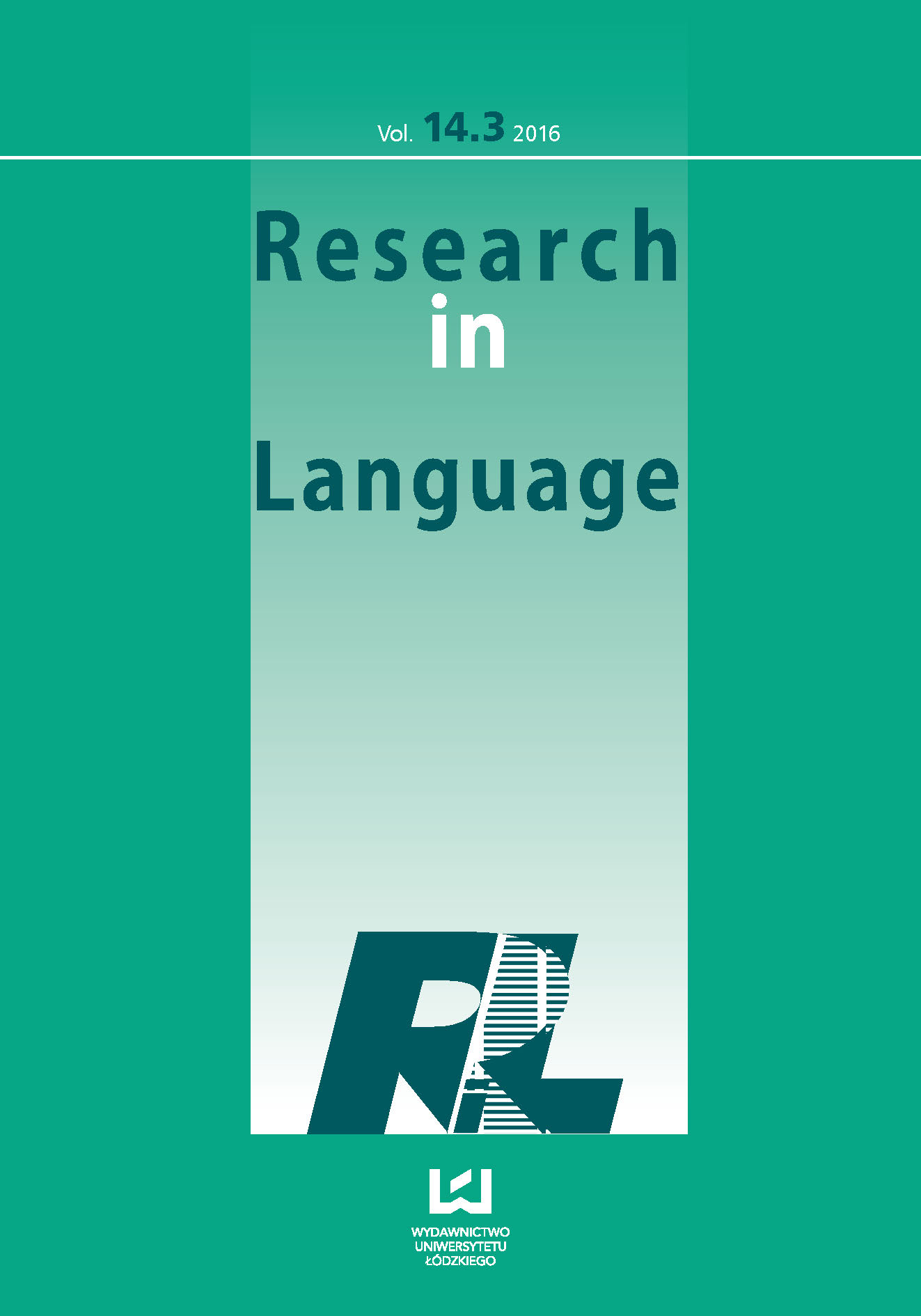Neutralization in Aztec Phonology – The Case of Classical Nahuatl Nasals
DOI:
https://doi.org/10.1515/rela-2016-0015Keywords:
Classical Nahuatl, derivational optimality theory (DOT), coda neutralization, nasal assimilationAbstract
This article investigates nasal assimilation in Classical Nahuatl. The distribution of nasal consonants is shown to be the result of coda neutralization. It is argued that generalizations made for root and word level are disproportionate and cannot be explained through the means of rule-based phonology. It is shown that the process responsible for nasal distribution can only be accounted for by introducing derivational levels in Optimality Theory.
References
Andrews, J. R. 2003. Introduction to Classical Nahuatl. Revised Edition. Norman: University of Oklahoma Press.
Google Scholar
Bermudez-Otero, R. 2003. The acquisition of phonological opacity. In J. Spenader, A. Eriksson and O. Dahl (eds.), Variation within Optimality Theory: Proceedings of the Stockholm Workshop on `Variation within Optimality Theory´, 25-36. Stockholm: Department of Linguistics, Stockholm University.
Google Scholar
Beckman, Jill N. 1997. Positional faithfulness, positional neutralization and Shona vowel harmony. Phonology 14. 1-46.
Google Scholar
Bermudez-Otero, R. forthcoming. Stratal Optimality Theory. Oxford: Oxford University Press.
Google Scholar
Booij, G. 2011. Morpheme Structure Constraints. In M. Van Oostendorp (ed.), The Blackwell Companion to Phonology, 2049-2069. Malden, MA: Wiley-Blackwell.
Google Scholar
Canger, U. 1980. Ochpantzintli and Classical Nahuatl Syllable Structure. Estudios de Cultura Nahuatl 14. 361-373.
Google Scholar
Campbell, R. J. and F. Karttunen. 1989. Foundation Course in Classical Nahuatl. Volume 2: Vocabulary and Key. Missoula: University of Montana.
Google Scholar
Carochi, H. 2001. Grammar of the Mexican Language: With an Explanation of Its Adverbs. [Translated by J. Lockhart]. Stanford: Stanford University Press. (Original work published 1645)
Google Scholar
Casali, Roderick. 1997. Vowel elision in hiatus contexts: Which vowel goes? Language 73: 493-533.
Google Scholar
Chomsky, N. and M. Halle. 1968. The Sound Pattern of English. New York: Harper and Row.
Google Scholar
Clements, G. N. 1985. The Geometry of Phonological Features. Phonology Yearbook 2. 223-252.
Google Scholar
Goldsmith, J. A. 1990. Autosegmental and metrical phonology. Oxford: Basil Blackwell.
Google Scholar
Hammond, R. M. 2001. The Sounds of Spanish: Analysis and Application. Sommerville: Cascadilla Press.
Google Scholar
Halle, Morris. 1992. Phonological features. In William Bright (ed.), International encyclopedia of linguistics, vol. 3, 207–212. Oxford: Oxford University Press.
Google Scholar
Ito, J. 1986. Syllable theory in prosodic phonology. Doctoral dissertation, University of Massachusetts, Amherst. New York: Garland Press.
Google Scholar
Jakobson, R. 1965. Quest for the Essence of Language. Diogenes 13. 21-37.
Google Scholar
Jun, J. 1995. Perceptual and articulatory factors in place assimilation: an optimality theoretic approach. PhD dissertation, University of California, Los Angeles.
Google Scholar
Jun, J. 2004. Place assimilation. In Bruce Hayes, Robert Kirchner and Donca Steriade (eds.), Phonetically based phonology, 58–86. Cambridge: Cambridge University Press.
Google Scholar
Kahn, D. 1976. Syllable-based generalizations in English phonology. Ph.D. diss., Dept. of Foreign Literatures and Linguistics, Massachusetts Institute of Technology.
Google Scholar
Karttunen, F. 1992. An Analytical Dictionary of Nahuatl. University of Oklahoma: Norman and London.
Google Scholar
Kiparsky, P. 1985. Some Consequences of Lexical Phonology. Phonology Yearbook 2. 85-138.
Google Scholar
Kiparsky, Paul. 1997. LP and OT. Handout. Ithaca, N.Y.: Cornell Linguistic Institute.
Google Scholar
Kiparsky, P. 2000. Opacity and Cyclicity. The Linguistic Review. 17. 351-376.
Google Scholar
Lockhart, J. 2001. Nahuatl as Written: Lessons in Older Written Nahuatl With Copious Examples and Texts. Stanford: Stanford University Press.
Google Scholar
Lombardi, L. 1997. Why Place and Voice are different: constraint-specific repairs in Optimality Theory. Ms, University of Maryland, College Park.
Google Scholar
McCarthy, J. J. and A. Prince. 1994. “The Emergence of the Unmarked: Optimality in Prosodic Morphology”. Papers from the Annual Meeting of the North East Linguistic Society 24. 333–379.
Google Scholar
McCarthy, J. J. and A. Prince. 1995. Faithfulness and reduplicative identity. In J. N. Beckman, L. W. Dickey, and S. Urbanczyk (eds.), Papers in Optimality Theory. University of Massachusetts Occasional Papers in Linguistics 18, 249–384. Amherst: University of Massachusetts, GLSA.
Google Scholar
McCarthy, J. J. 2008. The Gradual Path to Cluster Simplification. Phonology 25. 271-319.
Google Scholar
Mohanan, K. P. 1993. Fields of attraction in phonology. In: J. A. Goldsmith (ed.), The last phonological rule : reflections on constraints and derivations, 61–116. Chicago: University of Chicago Press.
Google Scholar
Ohala, J. J. 1986. Consumer’s guide to evidence in phonology. Phonology Yearbook 3. 3–26.
Google Scholar
Ohala, J. J. 1990. The phonetics and phonology of aspects of assimilation. In J. Kingston and M. E. Beckman (eds.), Papers in laboratory phonology I: between the grammar and physics of speech, 258–275. Cambridge: Cambridge University Press.
Google Scholar
Padgett, J. 1995. Partial class behavior and nasal place assimilation. In K. Suzuki and D. Elzinga (eds.), Proceedings of the 1995 Southwestern Workshop on Optimality Theory (SWOT), 145-183. Tucson: Department of Linguistics, University of Arizona.
Google Scholar
Prince, A. and P. Smolensky. 1993. Optimality Theory: Constraint Interaction in Generative Grammar. Ms., Rutgers University, New Brunswick, N.J., and University of Colorado, Boulder.
Google Scholar
Rubach, J. 1997. Extrasyllabic consonants in Polish: Derivational Optimality Theory. In Iggy Roca (ed.), Derivations and constraints in phonology, 551-581. Oxford: Oxford University Press.
Google Scholar
Rubach, J. 2000. Glide and Glottal Stop Insertion in Slavic Languages: A DOT Analysis. Linguistic Inquiry 31(2). 271-317.
Google Scholar
Sagey, E. C. 1986. The Representation of Features and Relations in Non-Linear Phonology. Ph.D. diss., Dept. of Linguistics and Philosophy, Massachusetts Institute of Technology.
Google Scholar
Salcedo, C. S. 2010. The Phonological System of Spanish. Revista de Linguistica y Lenguas Aplicadas 5. 195-209.
Google Scholar
Schane S. A. 1984. The Fundamentals of Particle Phonology. Phonology 1. 129-155.
Google Scholar
Selkirk, E. 1982. The syllable In H. van der Hulst and N. Smith (eds.), The structure of phonological representations II, 337-383. Dordrecht: Foris.
Google Scholar
Steriade, D. 2001. Directional asymmetries in place assimilation: a perceptual account. In: E. Hume and K. Johnson (eds.), The role of speech perception in phonology, 219-250. San Diego: Academic Press.
Google Scholar
Webb, C. 1982. A constraint on progressive consonantal assimilation. Linguistics 20. 309-321.
Google Scholar
Wilson, C. 2001. Consonant Cluster Neutralisation and Targeted Constraints. Phonology 18. 174-197.
Google Scholar










